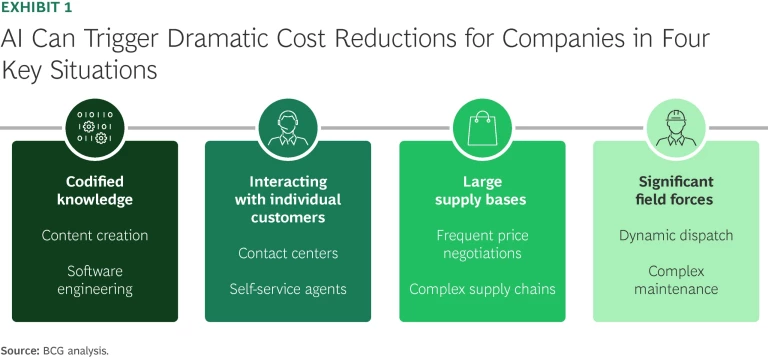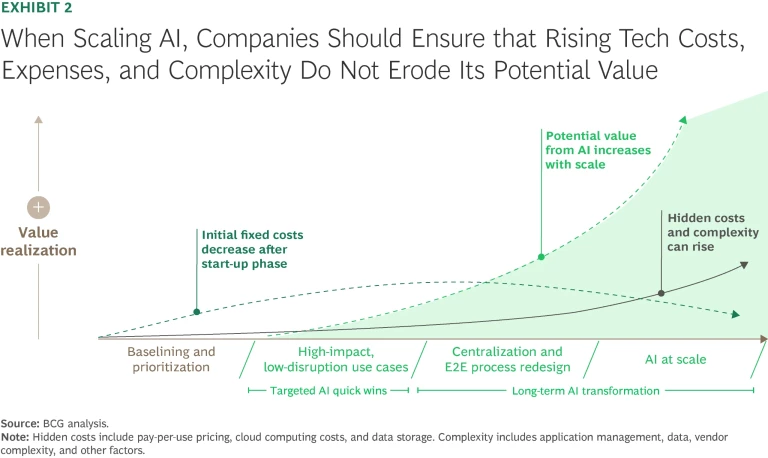CEOs and other C-suite leaders seeking to reduce costs know that AI is part of the equation, but in many cases, they struggle to make the math work. After investing to implement AI, the cost savings often don’t materialize. Consider that 93% of executives are planning to invest in AI over the next 18 months, recognizing the critical role it can play in reducing costs. Yet according to BCG’s Guide to Cost and Growth, only about half of companies hit their cost-reduction targets.
Despite these challenges, some succeed. Our research found that 26% of companies have scaled AI solutions across at least one function and have the capabilities in place to generate value from it. Notably, these companies report faster revenue growth, higher shareholder return, more innovation, and greater employee satisfaction. These AI leaders aren’t limited to hyperscalers or digital natives—more than half are traditional incumbents across various sectors.
What do these organizations do differently? After working with over 1,000 clients on cost reduction and AI in the past year—including generative AI (GenAI) and agentic AI—we see clear patterns in how they integrate the technology into cost programs. We’ve distilled these concepts into Driving Sustainable Cost Advantage with AI, a clear guide with actionable strategies to create bottom-line impact from AI quickly.
AI Offers Value in Four Key Situations
Although AI can be deployed in a wide range of applications and needs, we believe there are four specific conditions in which it can deliver the biggest impact on the cost base for companies. Each has high-volume processes and transactions that AI can learn from and optimize. (See Exhibit 1.) These situations—and the AI benefits realized by our client work—are described below.

Heavy reliance on codified knowledge.
Companies that produce outputs based on an organization’s knowledge of specific processes—such as internal or external content creation or software engineering—can use GenAI to make production processes about 50 times more efficient and reduce costs by 20% to 30%. For example, a consumer goods company used AI to transform marketing processes end-to-end. Through that effort, the company improved marketing productivity, reduced agency costs, and accelerated the production and adaptation of content, leading to a projected savings of €250 million in overall marketing costs.
Interaction with individual customers.
Organizations that have large customer bases and frequent interactions through call centers can use chatbots and GenAI-enabled assistants to handle some of those inquiries and categorize others, reducing the workload on in-store or call-center staff. As a result, these companies can use smaller employee teams and reduce costs by up to 90%. A global asset manager optimized customer support operations using AI, automating processes and reducing operating expenses by a third—equivalent to $100 million in bottom-line impact.
Large supply bases.
Manufacturers and other types of companies that have large supply bases and frequent price negotiations can leverage GenAI to identify price outliers and create tender documents and smart contracts. This can produce efficiency gains of up to 50%. Companies found that contract reviews which previously took two days could be completed in 20 minutes. A logistics company took this approach and used GenAI to create RFPs and handle other support processes, improving efficiency in the procurement function by 30% to 50%.
Significant field forces.
Companies that have large workforces in the field, such as maintenance or sales teams, can improve operational workflows with GenAI, improving the productivity of individual employees by 20% to 30%. An oil and gas company now uses GenAI to enhance maintenance operations, reducing errors by 70% and decreasing the cost of preventive maintenance by more than 40%.
Stay ahead with BCG insights on cost management
How to Avoid Common AI Transformation Pitfalls
Transformation at any level of an organization can be difficult, with potential missteps and difficulties that can hamper successful efforts. Our client work points to specific pitfalls in AI-enabled cost transformation that industry leaders should avoid.
Don’t forget to cash the check.
AI is a powerful technology, but it is not a magic wand. Leaders will only capitalize on its potential if they have the discipline to change processes, reorganize people, and shape the culture to execute on the business case and take cost out. BCG’s work in helping companies implement AI has found that only about 10% of the benefits are achieved from the algorithmic model that is deployed, 20% comes from the data used, and the remaining 70% comes from developing new behaviors and ways of working. Companies need to reorganize roles to put the right talent in the right position with the right skills. They must also adapt processes to enable seamless human–AI interactions and create agile learning cycles to rapidly innovate, learn, and pivot as the technology evolves.
Be vigilant about rising tech expenses and complexity.
AI at scale can result in higher tech costs and complexity as utilization grows. (See Exhibit 2.) Be vigilant about tracking down hidden costs, particularly with third-party vendors, who often seek to increase prices once enterprise customers are locked into a given solution. Companies must also focus on a manageable number of applications to avoid the kind of tech complexity that can overwhelm cost transformations.

Structure the implementation to capture savings as quickly as possible.
The pace of AI adoption can significantly impact the overall efficacy of cost reduction initiatives. Look for quick wins early on to unlock resources and generate momentum for more comprehensive efforts over the long term.
Rigorously track value.
Companies should avoid the trap of adopting technology for its own sake. Ensure that AI applications are linked to business objectives, improve productivity, and unlock financial savings that flow through to the bottom line.
Integrating AI into broader cost transformation efforts can lead to better outcomes by eliminating redundant or unproductive work, creating a better experience for customers and employees, and unlocking far greater savings than traditional cost levers can generate. In that way, AI-enabled transformations are giving companies a sustainable cost advantage.

















